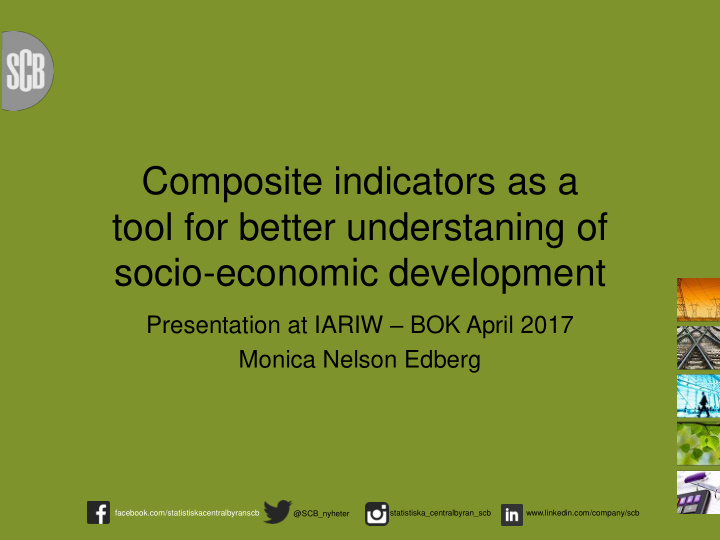



Composite indicators as a tool for better understaning of socio-economic development Presentation at IARIW – BOK April 2017 Monica Nelson Edberg facebook.com/statistiskacentralbyranscb statistiska_centralbyran_scb www.linkedin.com/company/scb @SCB_nyheter
Indicators as statistical tools Leading, Composite and Sentiment indicators demanded for use as tools and measures Increases consistency and comparability Need of ” Evidence-based data” Indicators are more; User friendly as a first glance Timeliness is better Quality depends on input data
Changing user needs Increased need for reflecting technological and economic change in new ways. Integrated statistical systems demanded Users demand ”sets of indicators ” or ” dash boards” Evidence based data base for better decision making
Stiglitz-Sen-Fitoussi message The indicators produced by the national accounts should be put to better use. GDP is only one of them. GDP was initially designed for the purpose of tracking economic activity and is not the index best suited to the notion of the population ´ s well-being. Other monetary indicators produced in the national accounts may be preferred to GDP. Many aspects of well-being remain difficult or impossible to measure in money units and greater importance should be attached to more quality-oriented indicators. Some of these non-monetary indicators remain objective but the report also recommends the use of subjective indicators. The measurement of current well-being and that of its sustainability are two issues that should be clearly separated. With sustainability, the question is whether we are passing sufficient resources on the future generations to assure them a standard of well-being at least equivalent to ours. This questions has several sub-dimensions; economic sustainability which can be appraised using monetary indicators and environmental sustainability which is best explored via a set of physical indicators Irrespective of the domain, aggregated indices cannot be used to capture the disparity between individual situations. The commission recommends complementing them within indicators of dispersion, where possible.
The statistical pyramide
The socio- economic field Measures of life satisfaction or happiness Measuring social progress Quality of life; well-being and life situation Economy – Environment and Social aspects in one place HDI the most known socio-economic indicator
Social progress – not only GDP
Social capital - a broad base indicator Social Capital Participation Trust Political Trust Organizational Social Political Organizational participation Social Trust participation participation trust
Standardized Indicators Composite indicators not common by national statistical offices (NSOs) There are standardized models available but these are seldom used. By using the standard models, comparision and quality can be strenghthened NSOs have the competence and knowledge to construct high-qualitative LCS-indicators
UNECE guide on LCS-indicators Give advice to NSOs who wants to get more involved in LCS-indicators Use available models from UN, OECD and Eurostat. Show examples how constructions is done today Encourage NSOs to develop in this area, to meet user needs for socio-economic indicators on a bae of high quality, comparability and on a solid statistical ground
Recommend
More recommend